The decline in the number of Americans who say they enjoy the news is a continuation of a long-term trend. In 1995, a majority (54%) said they enjoyed keeping up with the news a lot. That number fell to 50% in 1998 and 45% this year.
While Americans remain generally satisfied with the quality of television news and overall TV programming, the trend here is negative as well. About one-third (32%) say they are very satisfied with the choice of TV news fare, down from 35% in 1998 and 43% in 1994. The number who say they are fairly satisfied fell from 50% in 1998 to 48% today.
And when they do tune into the news, increasing numbers of today’s adults are fickle consumers. More than six-in-ten (62%) now watch television news with their remote controls in hand. With channel surfing on the rise, it is no surprise that overall news consumption remains largely event-driven. Slightly less than half of the public (48%) actually follows national news on a regular basis; fully 50% tune in only for significant or interesting events.
Still, Americans continue to place a high value on the importance of the news. Nearly three-quarters (73%) think that news today is as important as ever. A strong majority (62%) appreciates having so many news and information choices available, and over half (53%) wish they could devote more time to the news.
Older and Overloaded
Most Americans enjoy the variety of options brought on by the ever-expanding number of TV news shows, magazines, newspapers and online information services. This is especially true for younger Americans, 70% of whom laud the new technologies. But older adults — the most avid news consumers — are most likely to feel burdened by the expansion and proliferation of news sources.
 Four-in-ten senior citizens (41%) say that all the TV shows, magazines, newspapers, and computer information services make them feel overloaded. Just 21% of adults under age 30, 27% of those ages 30-49 and 35% of the 50-64 age group agree. Americans with less education are also more apt than those with more education to feel overwhelmed by the number of news sources currently available.
Four-in-ten senior citizens (41%) say that all the TV shows, magazines, newspapers, and computer information services make them feel overloaded. Just 21% of adults under age 30, 27% of those ages 30-49 and 35% of the 50-64 age group agree. Americans with less education are also more apt than those with more education to feel overwhelmed by the number of news sources currently available.
Online news consumers are especially enthusiastic about the plethora of news choices. Three-quarters (76%) of those who turn to the Internet for news at least once a week appreciate having a variety of options. Only slightly more than half (52%) of those who don’t go online agree.
Age, Education Matter
Beyond the overall decline in the number of Americans who like following the news, there are major differences on this issue based on age and education. As has been true in previous years, older and better-educated Americans enjoy following the news a lot more than do younger adults and those with less schooling.
Only 31% of those age 18-29 like keeping up with the news a great deal. Nearly twice as many (57%) of those age 50 and over agree. Among those without any college experience, just 41% enjoy following the news, compared to 54% of college graduates.
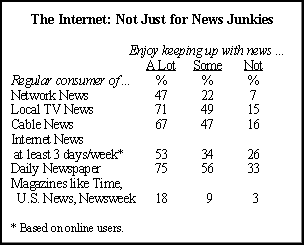 Not surprisingly, those who most enjoy following the news tend to be the heaviest news consumers. This holds true for all types of media. News enthusiasts watch television news more regularly, read newspapers more often, and follow all types of news — international, national and local — at higher rates. They are also more avid consumers of news online. Among Internet regulars, 53% log on for news at least three days a week.
Not surprisingly, those who most enjoy following the news tend to be the heaviest news consumers. This holds true for all types of media. News enthusiasts watch television news more regularly, read newspapers more often, and follow all types of news — international, national and local — at higher rates. They are also more avid consumers of news online. Among Internet regulars, 53% log on for news at least three days a week.
But the Internet is also attracting those who don’t enjoy the news. Fully one-quarter (26%) of online users who say they don’t like following the news still turn to the Internet for news at least three days a week. In fact, these lukewarm news consumers are more likely to log onto the Internet for news than watch network, local and cable television news.
Clearly, time constraints have made it more difficult for Americans to pay attention to the news. Over half (53%) of the public says they wish they had more time to follow the news. Women — especially working mothers — express this desire to a greater degree than do men. Fully 58% of women want more time to follow the news; 48% of men agree. Almost two-thirds (65%) of working mothers want more time to focus on the news.
Most Remain Satisfied with TV
Despite the declining audience for television news, a higher percentage of Americans express satisfaction with the quality of news programs than general television fare. While eight-in-ten are at least fairly satisfied with television news, 58% say the same about all television content.
Young people show a decided lack of enthusiasm for the news, but they tend to be more satisfied with general television programming than do older Americans. Seven-in-ten of those under age 30 say they are satisfied with TV programming; 57% and 52%, respectively, of adults ages 30-49 and 50 and older agree. Parents in the 30-49 age group appear especially frustrated with TV offerings. Only about half (51%) say they are satisfied. Perhaps not surprisingly, cable TV subscribers are more satisfied with the choices available on TV than are those who don’t have cable in their homes.
When it comes to TV news, the satisfaction is more widespread. Majorities of all major demographic, religious and political groups say they are satisfied with TV news choices. Nonetheless, satisfaction levels have fallen somewhat in recent years. And today, among Internet users, those who are dissatisfied with TV news choices turn to online sources for news slightly more often than do those who are satisfied with TV choices, 33% vs. 26%, respectively.
Business Coverage Rated Highly
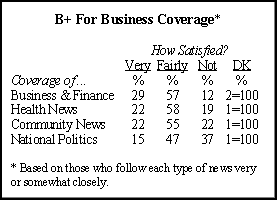 Americans give favorable reviews to the media’s coverage of various types of news. Among those who follow each type of news, over 75% say they are at least fairly satisfied with coverage of business and finance issues, health news and events and people in their communities. Coverage of political events and issues in Washington is less highly rated: 62% say they are satisfied with this coverage.
Americans give favorable reviews to the media’s coverage of various types of news. Among those who follow each type of news, over 75% say they are at least fairly satisfied with coverage of business and finance issues, health news and events and people in their communities. Coverage of political events and issues in Washington is less highly rated: 62% say they are satisfied with this coverage.
Women express somewhat more satisfaction with the media’s coverage of Washington politics than do men: 65% vs. 58%, respectively, among those who follow this type of news closely. Less well-educated adults are also more satisfied with national political coverage: 65% of those with no college training are satisfied, compared to 58% of those with college degrees. Regular talk-radio listeners are among the least satisfied. Just 46% express satisfaction, compared to 62% of the population at large.
Hispanics and blacks who follow community news closely are slightly less satisfied with the news media’s coverage in this area than are whites, although large numbers are relatively content. Seven-in-ten blacks and 69% of Hispanics say they are satisfied with this coverage, compared to 79% of whites.
Although solid majorities of all major groups express satisfaction with the media’s coverage of health news, community news and news about business and finance, Americans are divided on in their opinions as to whether executives and editors in the news media are out of touch. Just over half (53%) of the public believe that newspaper and TV news executives are out of touch with people like them; 44% disagree. Older Americans, adults with less education, and white evangelical Protestants are among the most likely to complain about the news media’s connection to the public.
Roaming on the Rise
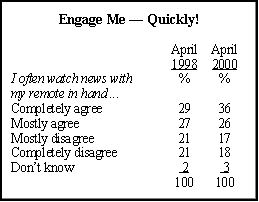 The public’s propensity for flipping channels has risen six percentage points since 1998 when 56% of the public reported watching TV news with remotes at the ready, compared to 62% today. Young people are especially attached to their clickers — about three-quarters (76%) of those under age 30 watch with remotes in hand, compared to 63% of 30-49 year-olds and 54% of the over 50 crowd.
The public’s propensity for flipping channels has risen six percentage points since 1998 when 56% of the public reported watching TV news with remotes at the ready, compared to 62% today. Young people are especially attached to their clickers — about three-quarters (76%) of those under age 30 watch with remotes in hand, compared to 63% of 30-49 year-olds and 54% of the over 50 crowd.
Daily online news consumers are somewhat more prone to flipping than are regular network news watchers: 67% of Internet news consumers say they click to another channel whenever their interest fades, compared to 62% of the rest of the public. People who don’t enjoy following the news are also more likely to watch TV news with remote controls at the ready. About two-thirds (68%) of adults who don’t get much pleasure from following the news click around; 56% of those who say they enjoy following the news a lot do so.
Event-driven Audiences
Fully 64% of Americans say that they only follow international events closely when something important or interesting is happening; just 33% pay close attention most of the time.
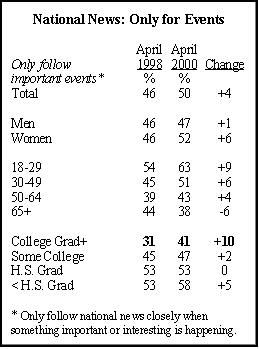 This inattentiveness to international news was evident in 1998, but now more Americans appear to be turning away from national news as well. Half the public now says that they follow national events only when something important is happening, a slight jump from the 46% who said so in 1998. Although college-educated Americans are still the most attentive news followers, attention even among this group is falling off at a fairly rapid pace. Now, 41% of those with college degrees pay attention to national news only when important events are happening; in 1998 just 31% were this inattentive.
This inattentiveness to international news was evident in 1998, but now more Americans appear to be turning away from national news as well. Half the public now says that they follow national events only when something important is happening, a slight jump from the 46% who said so in 1998. Although college-educated Americans are still the most attentive news followers, attention even among this group is falling off at a fairly rapid pace. Now, 41% of those with college degrees pay attention to national news only when important events are happening; in 1998 just 31% were this inattentive.
Event-driven news consumers are also disproportionately young. Fully 63% of adults under age 30 follow national news closely only when something important or interesting is happening; in 1998, 54% were event-driven news consumers.
Taken together, a sizable group of Americans (43%) follow both national and international news only when something important is happening. There is a very clear generational pattern on this measure. More than half (52%) of those under 30 fall into this group, compared to 45% of those aged 30-49 and only 34% of those over age 50.
These event-driven news consumers are much less likely than those who follow the news consistently to say they enjoy keeping up with the news (26% enjoy this a lot, vs. 70% of those who follow the news most of the time). They’re also more likely to feel overloaded by the myriad of news offerings, and they’re less satisfied with the choice of news programs on available on TV.
Only about a quarter of the public (27%) follows national and international news most of the time, whether or not something important or interesting is happening. More men than women fall into this category. This group is older and more well-educated than average. In addition, those who get news online on a daily basis are more likely than most to follow this pattern of news consumption (34% vs. 27% among the general public).
Just My Facts, Please
While most of the public wants news that contains general information about important events, a substantial 28% say they prefer news that focuses on their own concerns and interests. This group is disproportionately young and male: Fully 39% of men under age 30 say they want news that addresses their interests. About one-third (32%) of all men but just 24% of all women express this view.
Less well-educated Americans express a greater preference for news that caters to their personal interests, rather than more generalized news. Among those whose education ended with high school, 30% want news that addresses their personal concerns. Only 21% of college-educated adults pick the specialized over the general.
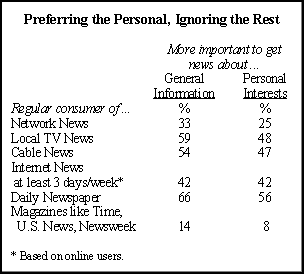 Americans who want specialized news consume less mainstream news than do those who favor more generalized news reporting. They watch TV news less frequently, are less apt to read a daily newspaper, and are less likely to be regular viewers of local news programs. Compared to those who prefer generalized reporting, this group is less constant in their attention to international, national and local news, tuning in only for important events.
Americans who want specialized news consume less mainstream news than do those who favor more generalized news reporting. They watch TV news less frequently, are less apt to read a daily newspaper, and are less likely to be regular viewers of local news programs. Compared to those who prefer generalized reporting, this group is less constant in their attention to international, national and local news, tuning in only for important events.
Indeed, the only way in which those with particularized news interests do not differ substantially from the rest of adults is in their Internet news consumption. Both groups go online for news at equal rates.
Where Americans Go for Breaking News
Given the public’s diverging news tastes and habits, it is perhaps not surprising that Americans would scatter among different media outlets even during times of crisis. The Pew Research Center survey included a series of open-ended questions which asked people where they would go to find out about certain hypothetical breaking news events.
Under one scenario, respondents were asked where they would go for news if there had been a major terrorist attack on a large U.S. city. In this case, most Americans would turn on their television sets, but they wouldn’t tune in to the broadcast networks. By a better than two-to-one margin, they would turn to cable TV outlets, primarily CNN.
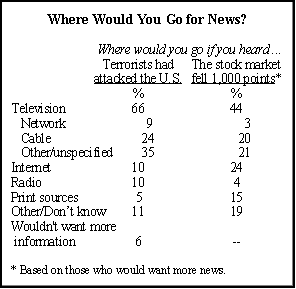 As many Americans would go to the Internet for more information on a terrorist attack as would choose network TV. Fully 10% would go online to learn more about such an event. A similar proportion would turn on the radio. Very few (5%) say they would wait for the morning newspaper.
As many Americans would go to the Internet for more information on a terrorist attack as would choose network TV. Fully 10% would go online to learn more about such an event. A similar proportion would turn on the radio. Very few (5%) say they would wait for the morning newspaper.
Even more Americans would go online for news and information if they heard that the stock market had fallen 1,000 points. In this case, the Internet outpaces even cable TV. A sizable percentage (32%) say they wouldn’t be interested in getting more information about such a stock market dive. However, among those who would seek out news right away, fully a quarter (24%) say they would go online. One-in-five would turn to cable TV, and a mere 3% would turn to the networks. Fifteen percent would rely on newspapers and magazines.
The Public’s News Interests
Crime, health, and sports are the three types of news followed most closely by the American public. Fully three-in-ten Americans follow crime stories very closely. Health and sports news weigh in behind crime at 29% and 27%, respectively. Community news and religion round out the top five news interests (26% and 21%).
There are significant gender differences underlying the public’s appetite for news. The top three news interests of women are health, crime and community, while men are mostly interested in sports, crime and science and technology.
 Men also follow international affairs and business and financial news at higher rates than women. Fully one-in-five men follow both these types of news very closely, compared to 10% of women who follow international affairs and 8% who follow business and financial news.
Men also follow international affairs and business and financial news at higher rates than women. Fully one-in-five men follow both these types of news very closely, compared to 10% of women who follow international affairs and 8% who follow business and financial news.
News about political figures and events in Washington continues to rank low on the public’s list of news interests. People who identify themselves as independents are the least interested in news about political figures and events in Washington. Only 10% say they follow this kind of news very closely, compared to 20% of Democrats and 21% of Republicans.
Blacks Closely Track Community News
There are some notable differences in news consumption habits among blacks, whites and Hispanics. While fewer African-Americans than whites read a daily newspaper, blacks watch television news at slightly higher rates than whites. Nearly half of whites (47%) report having read a daily newspaper yesterday, compared to 37% of blacks and 32% of Hispanics. On the other hand, nearly six-in-ten blacks report having watched TV news yesterday, compared to 56% of whites.
While local community news is popular among more than half of the American public, blacks have a particularly strong interest in this subject. Almost seven-in-ten blacks (67%) say they follow local community news closely most of the time whether or not something important is happening. This compares with 57% of whites and Hispanics. In addition, blacks watch local broadcast and cable news channels at significantly higher rates than whites or Hispanics.
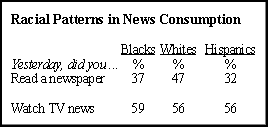 More blacks than whites say they enjoy keeping up with the news a lot (56% to 44%). However, blacks are less satisfied with the media’s coverage of people and events in their community, an area of prime interest to them. Almost three-in-ten African-Americans (29%) say they are dissatisfied with the coverage, while only two-in-ten whites (20%) agree.
More blacks than whites say they enjoy keeping up with the news a lot (56% to 44%). However, blacks are less satisfied with the media’s coverage of people and events in their community, an area of prime interest to them. Almost three-in-ten African-Americans (29%) say they are dissatisfied with the coverage, while only two-in-ten whites (20%) agree.
Crime and health are the top two news interests of blacks, Hispanics and whites alike, but there are clear differences after that. Blacks follow most types of news at a higher rate than whites and Hispanics. For example, almost twice as many blacks as whites follow crime news very closely (51% to 27%). And more than four-in-ten blacks (42%) follow religious news, compared to only 19% of whites and 20% of Hispanics.
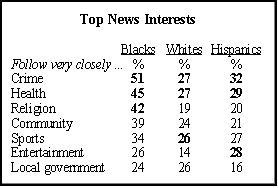 Blacks still lag behind whites and Hispanics in going online, but they are starting to access the Internet at slightly higher rates. The digital divide is still evident: 38% of blacks go online, compared to 56% of whites and 52% of Hispanics. Almost one-quarter of blacks (24%) now get news online at least weekly, compared to 33% of whites.
Blacks still lag behind whites and Hispanics in going online, but they are starting to access the Internet at slightly higher rates. The digital divide is still evident: 38% of blacks go online, compared to 56% of whites and 52% of Hispanics. Almost one-quarter of blacks (24%) now get news online at least weekly, compared to 33% of whites.


